
President Donald Trump's relationship with the Federal Reserve is, to put it mildly, evolving. Candidate Trump loathed the central bank, a luxury the man who currently holds the Oval Office no longer can afford.
As a result, Trump's rhetoric has abated considerably.
Where he once charged that Fed Chair Janet Yellen should be ashamed of herself, he has scarcely mentioned her name since he's been in office. Gone are the days of railing against asset bubbles and the loose monetary policy that often fuels them.
That's come as Trump has realized he may need the same low interest rates he accused the Fed of using for political purposes to prop up the economy under former President Barack Obama.
In short, things have changed a lot in 100 days.
"It's another one of his flip-flops," said economist Michael Pento, who said he voted for Trump but has been disappointed so far. "Now that he's the president, the stock market's no longer a bubble. ... Now he loves low interest rates and loves a weaker dollar."
The trouble for Trump is that the climate is shifting inside the the Fed. Officials on the policy-making Federal Open Market Committee are of a mind to increase rates gradually in the coming years, after going nearly a decade without making a move.
In a perfect world, the rate hikes would accompany a growing economy. However, multiple signs recently that growth may not achieve the breakout speed that the president has pledged are raising questions about whether the Fed could torpedo the Trump economy.
"All of a sudden, they've found their monetary manhood. They're raising rates aggressively, and for what reason?" said Pento, head of Pento Portfolio Strategies. "For some reason, there's been a watershed change in monetary policy, and it happened in December 2016. What is the trenchant difference between what preceded 2016 and what has ensued? There is no rationale other than they don't like Republicans."
Hoping for growth
The Fed did keep its benchmark short-term rate anchored near zero for most of Obama's administration, raising it once in December 2015, and again in December 2016, after the presidential election.
In addition to the low rates, the Fed expanded its balance sheet, or bond portfolio, to $4.5 trillion through three rounds of "quantitative easing." Now, the Fed not only is targeting rate hikes but also has begun discussing rolling off the securities it accumulated through the post-financial crisis years. Letting the balance sheet decline is akin to additional rate hikes, several Fed officials have said.
"The history of the Fed is they always stay too loose for too long," Pento said. "So we have 100 months of too-low rates, then they tighten rates, and when they loosen accommodation, asset bubbles pop and they send us into recession."
The idea of an impending recession remains an out-of-consensus view on Wall Street, though there have been concerns. Fed officials themselves in recent days have worried over asset prices that are too high, and policy that is too loose for too long risks causing a recession if the Fed is forced to tighten too quickly.
At present, though, the thinking inside the FOMC is that fiscal policy could provide a boost to the economy that could be on track to grow considerably faster than the meager 1.6 percent pace during the Obama years.
So while it may appear that the Fed's shift to tighten has political roots, members indicate it is rooted instead in a belief that the economy finally has shaken off the shackles of the Great Recession.
"Ultimately, the Fed is data dependent," said Quincy Krosby, market strategist at Prudential Financial. "Obviously, it's also the Trump agenda. How close do we get to the very core of what is supposed to spur growth?"
Threats to hike before
But there's no saying just how quickly the Fed will move, regardless of the rhetoric.
They had been talking about potential rate hikes for years. In 2016, projections from FOMC members indicated four rate hikes were on the way, but only one happened.
Fed Vice Chair Stanley Fischer, in a CNBC interview on Friday, said there probably would be three total increases this year but the committee wasn't wedded to that forecast. That''s a particularly important consideration in light of the trouble the Trump agenda recently has encountered from a recalcitrant Congress.
Trump is hoping that a three-pronged attack of lower tax cuts, less regulation and greater infrastructure spending will spur the kind of growth acceleration the Fed has been anticipating.
"Fiscal policy enters into that calculation, but indirectly into how it affects the job market and inflation," said Mark Zandi, chief economist at Moody's Analytics. "If we don't get the kind of stimulus that was widely expected that we would get a couple months ago, that means we're not going to get the same kind of temporary juiced-up growth."
Trump signed three directives Friday aimed at lowering regulations and examining the tax question. How far that goes could determine how far the Fed moves as well, though the central bank is more likely to stick to its key directives of full employment and a healthy inflation level.
"They are focused on the right thing, because fiscal policy is a big wildcard here," Zandi said. "It could provide a lot of near-term juice, or none at all."


